Physical Address
304 North Cardinal St.
Dorchester Center, MA 02124
A detailed understanding of aesthetic facial analysis is imperative to any cosmetic or reconstructive surgeon.
The names of both soft tissue and bony anatomic landmarks must be clear and are the basic language in which surgeons communicate.
Both nasal and nasofacial angles are the cornerstone of rhinoplasty analysis and planning.
Aesthetic subunits and relaxed skin tension lines are critical in designing surgical incisions and repairs.
Throughout history, mankind has tried to define beauty. Poets, philosophers, and artists have pondered its elusive quality while attempting to quantify that which is evident to all of us. As surgeons, however, we are required to have a more scientific approach to beauty to formulate operative plans with successful surgical outcomes. Common reference points are essential in both communications with colleagues and in medical record keeping. Furthermore, we must be able to accurately define specific characteristics that deviate from the norm so that we may identify congenital anomalies and facial deformities.
As early as ancient Egypt, aesthetic facial proportions have been idealized in art. However, it was not until the era of Greek philosophy that the study of beauty became a formal discipline. To Plato and Aristotle, beauty meant symmetry, harmony, and geometry. In the 5th century bce , the Greek sculptor Polyclitus defined “perfect beauty” as the mutual harmony of all parts, such that nothing could be added or subtracted. Such harmonic proportions were held to be beautiful in themselves, independent of any observer.
These ideas were later revisited by the Renaissance artists, who began to define ideal proportions for the human form. This example is nowhere more evident than in the drawings of Leonardo da Vinci and particularly his Vitruvian Man ( Fig. 16.1 ). It was da Vinci who formulated ideal facial proportions through the study of anatomy and divided the profile into equal thirds ( Fig. 16.2 ). Leonardo's scientific accuracy rivaled that of Vesalius, and the beauty of da Vinci's artistry remains unchallenged. Another Renaissance artist inspired by the Vitruvian notion of perfect proportions was the German printmaker Albrecht Dürer, who used his own finger as a unit of measurement to construct a proportional system for the entire body; in 1528, Dürer published a four-book treatise on human proportions, wherein he divided the facial profile into four equal parts and recognized that the length of the nose equals that of the ear.
The artistic canons set forth in antiquity and during the Renaissance dominated Western art for centuries. In the 20th century, anthropometrist Leslie Farkas and colleagues challenged these classic canons by measuring the facial proportions of 200 women, including 50 models. His results concluded that some of the canons are nothing more than artistic idealizations. Nevertheless, although social and cultural factors influence every generation's concept of beauty, these aesthetic canons have withstood the test of time. Currently, the parameters established in the facial plastic surgery literature are based predominately on the works of Powell and Humphreys, who in 1984 crystallized this topic into a single text, Proportions of the Aesthetic Face.
Facial analysis is dependent on both soft tissue and skeletal anatomic landmarks. Soft tissue reference points are shown in Fig. 16.3 and listed in Box 16.1 . Skeletal reference points are defined by cephalometric analysis and are shown in Fig. 16.4 and listed in Box 16.2 . The nasal root and dorsum have multiple identifying names, and the reader should be aware of subtle but important differences. Examples include nasion, radix, rhinion, and sellion.
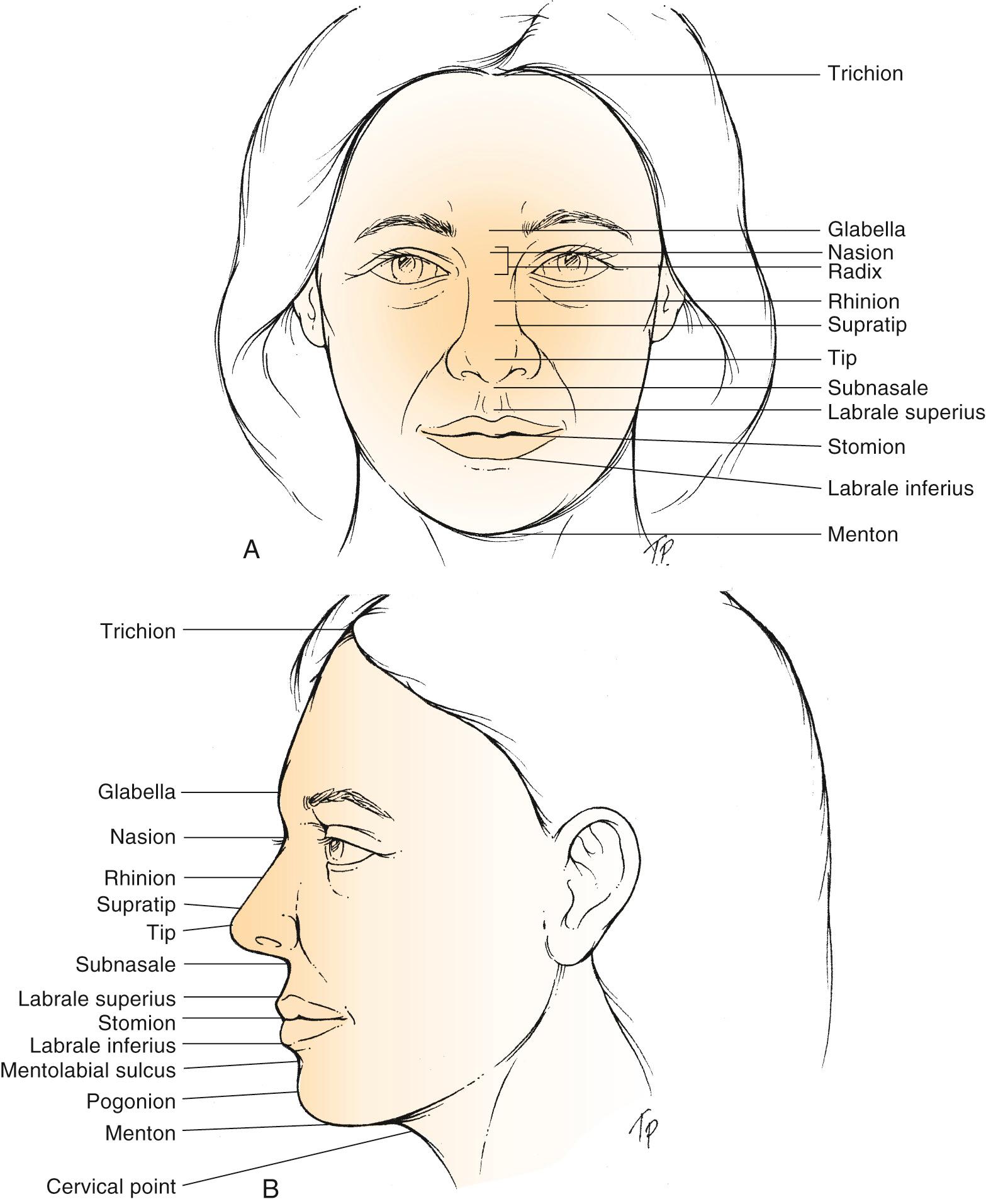
Trichion (Tr): Anterior hairline in the midline
Glabella (G): Most prominent point of the forehead on profile
Nasion (N): The deepest depression at the root of the nose; typically corresponds to the nasofrontal suture
Radix: Root of the nose, a region and not a point; part of an unbroken curve that begins at the superior orbital ridge and continues along the lateral nasal wall
Rhinion (R): Soft tissue correlate of the osseocartilaginous junction on the nasal dorsum
Sellion: Osseocartilaginous junction on the nasal dorsum
Supratip: Point cephalic to the tip
Tip (T): Ideally, the most anterior projection of the nose on profile
Subnasale (Sn): Junction of columella and upper lip
Labrale superius (Ls): Vermilion border of upper lip
Stomion (S): Central portion of interlabial gap
Stomion superius: Lowest point of upper lip vermilion
Stomion inferius: Highest point of lower lip vermilion
Labrale inferius (Li): Vermilion border of lower lip
Mentolabial sulcus (Si): Most posterior point between lower lip and chin
Pogonion (Pg): Most anterior midline soft tissue point of chin
Menton (Me): Most inferior soft tissue point on chin
Cervical point (C): The innermost point between the submental area and the neck
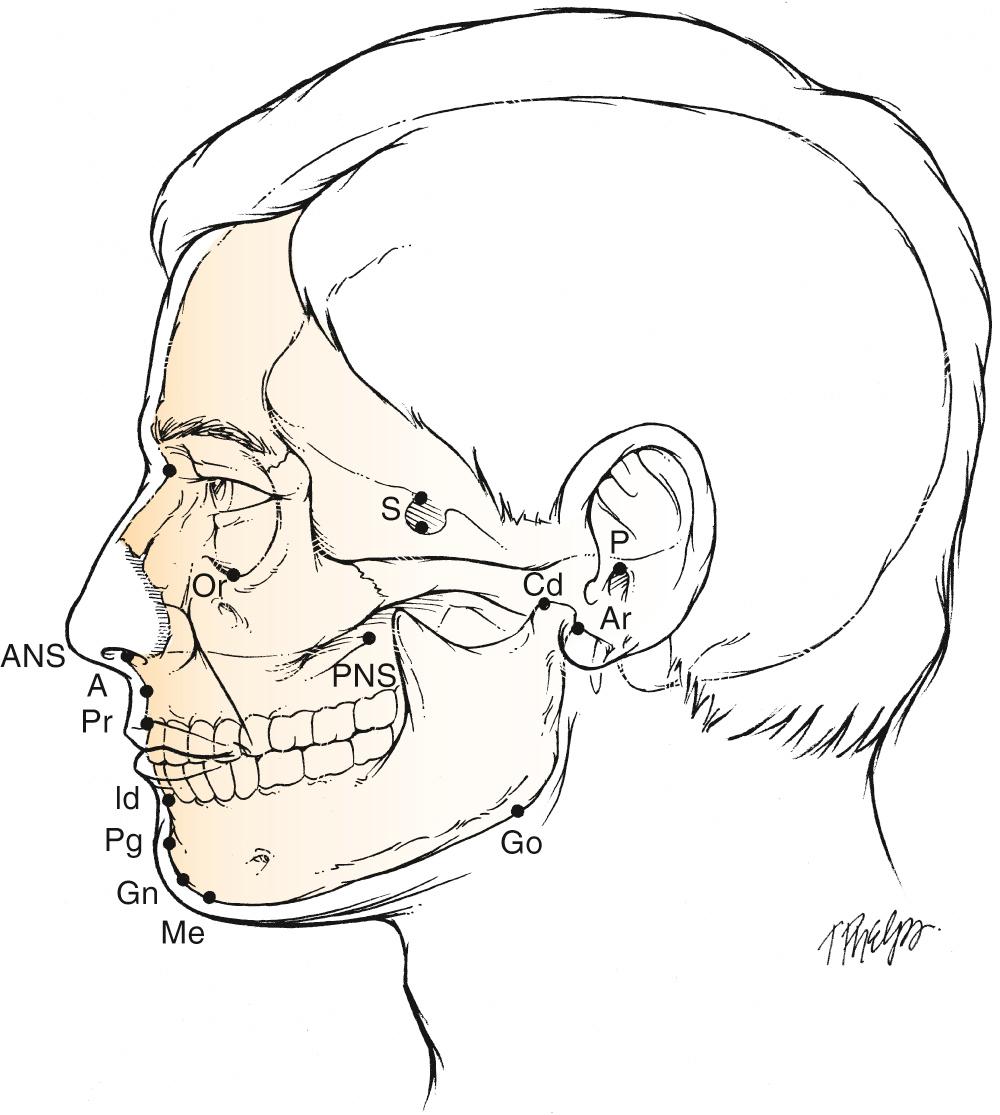
Sella (S): The midpoint of the hypophysial fossa
Orbitale (Or): The most inferior point on the infraorbital rim
Porion (P): The most superior point on the external auditory meatus
Condylion (Cd): The most superior point on the head of the mandibular condyle
Articulate (Ar): The point of intersection of the posterior margin of the ascending mandibular ramus and the outer margin of the cranial base
Anterior nasal spine (ANS)
Posterior nasal spine (PNS)
Point A, subspinale (A): The deepest point in the concavity of the premaxilla
Prosthion (Pr): The lowest, most anterior point on the alveolar portion of the premaxilla
Infradentale (Id): The highest, most anterior point on the alveolar portion of the mandible
Point B, supramentale (B): The most posterior point in the outer contour of the mandibular alveolar process
Pogonion (Pg): Most anterior point on the bony chin in the midline
Gnathion (Gn): A point between the most anterior (Pg) and inferior (Me) points on the chin
Menton (Me): The lowest point on the mandible
Gonion (Go): The midpoint at the angle of the mandible
The Frankfurt horizontal plane ( Fig. 16.5 ) is the standard reference point for patient positioning in photographs and cephalometric radiographs. The Frankfurt line is drawn from the superior aspect of the external auditory canal to the inferior border of the infraorbital rim while the patient's gaze is parallel to the floor. A soft tissue definition for the inferior aspect of the infraorbital rim is the point of transition between lower eyelid and cheek skin.
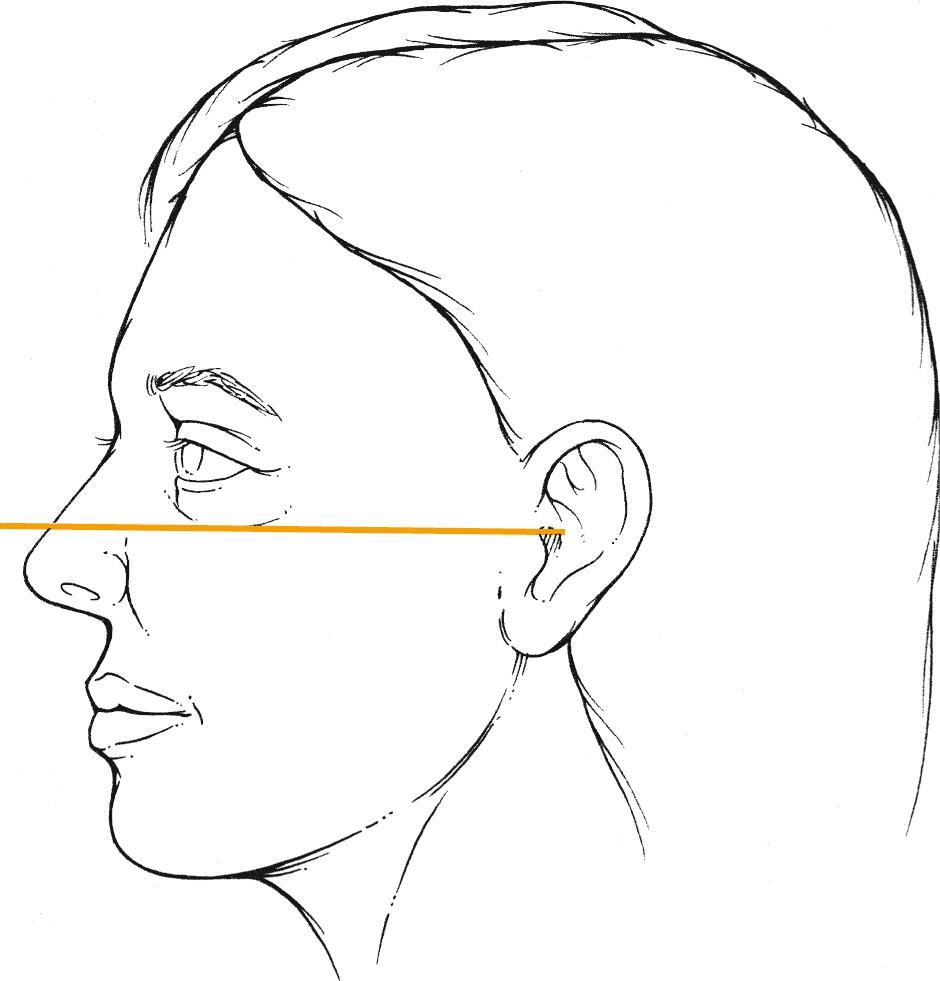
The initial assessment of the face evaluates symmetry, which is rarely perfect when comparing halves through a midsagittal plane ( Fig. 16.6 ); nevertheless, midline points should lie on the axis line. Facial width is evaluated by dividing the face into equal fifths ( Fig. 16.7 ). The width of one eye should equal one-fifth of the total facial width and should be the same as the intercanthal distance or nasal base width.
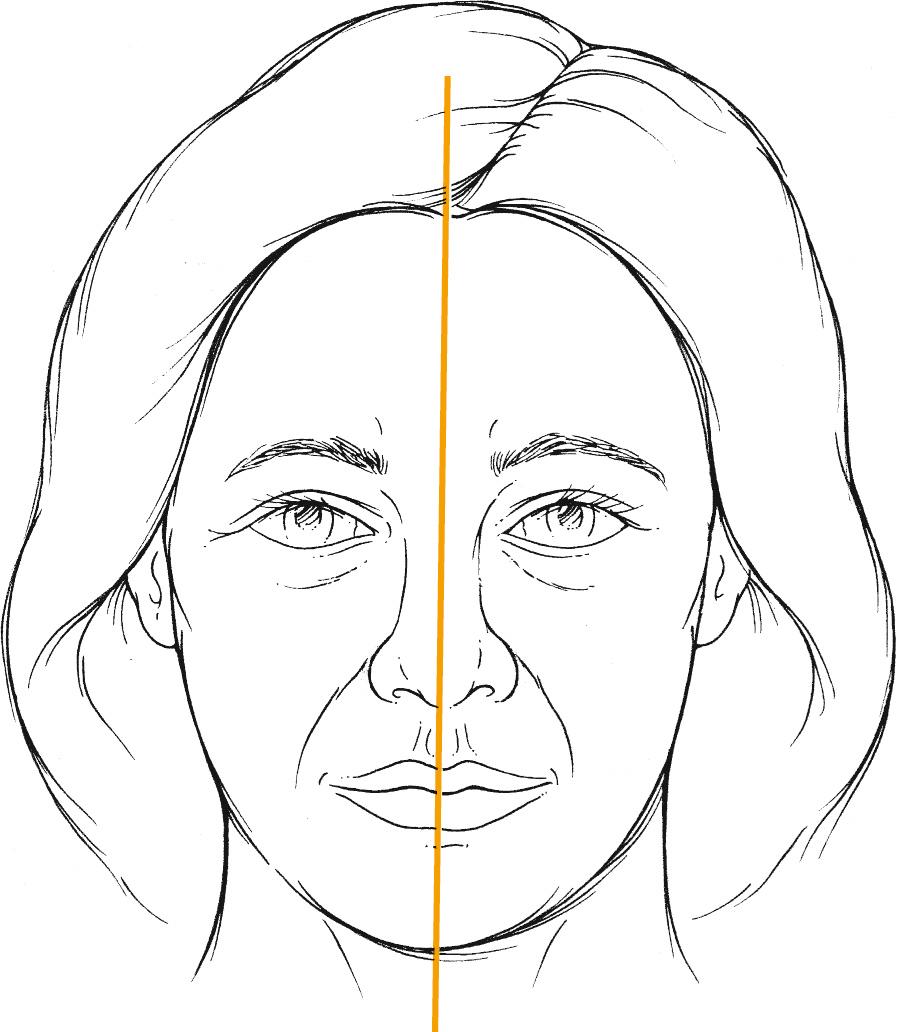
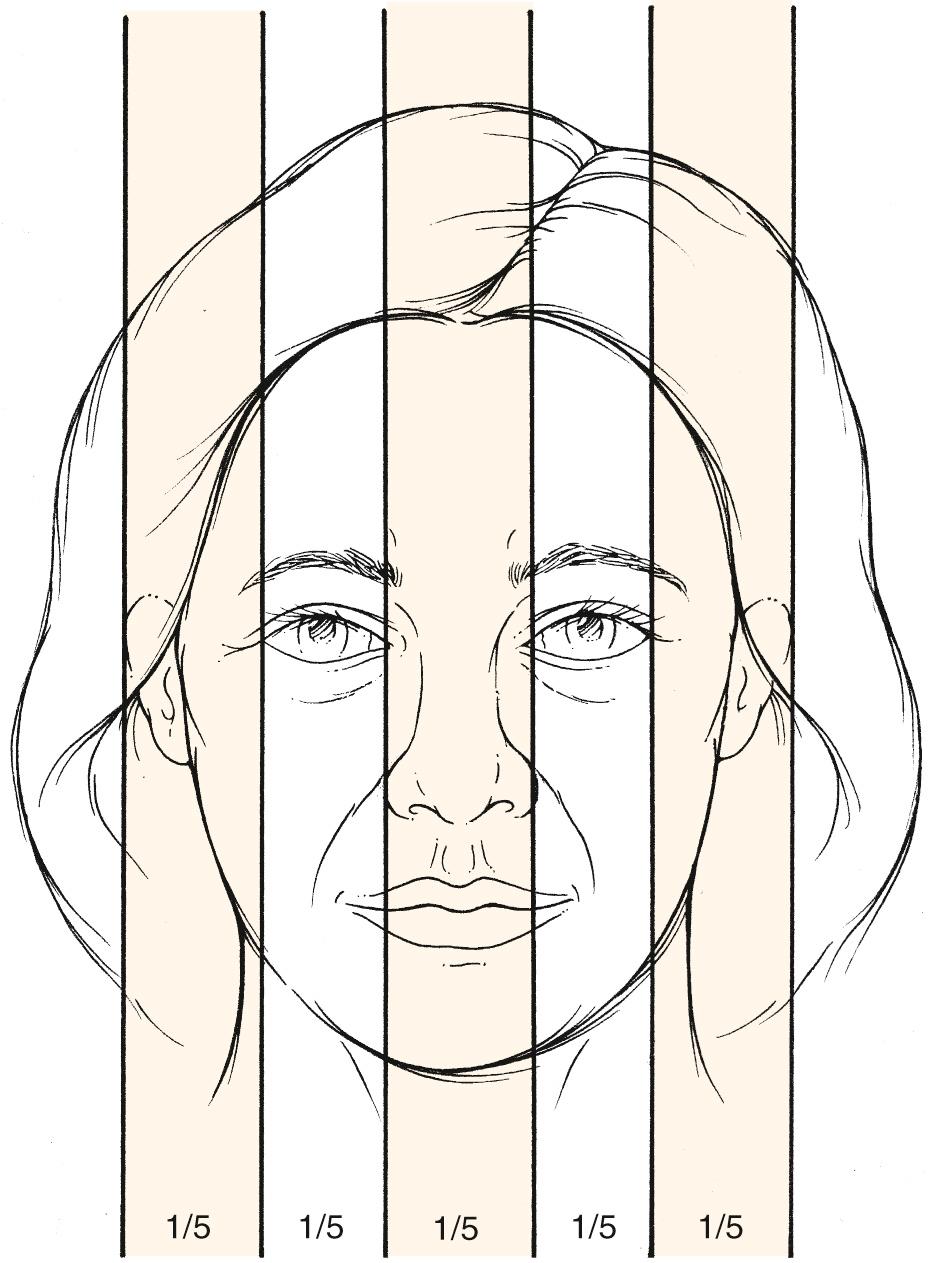
Facial height is commonly assessed by one of two methods. The first method divides the face into equal thirds ( Fig. 16.8 ) as described by da Vinci. Measurements are made in the midline, from the trichion to the glabella, from the glabella to the subnasale, and from the subnasale to the menton. The second method excludes the upper third of the face because of common variability regarding hairline position. Measurements are made from the nasion (as opposed to the glabella) to the subnasale and from the subnasale to the menton ( Fig. 16.9 ). With this method, the midface represents 43% of the height, with the lower face representing 57%.
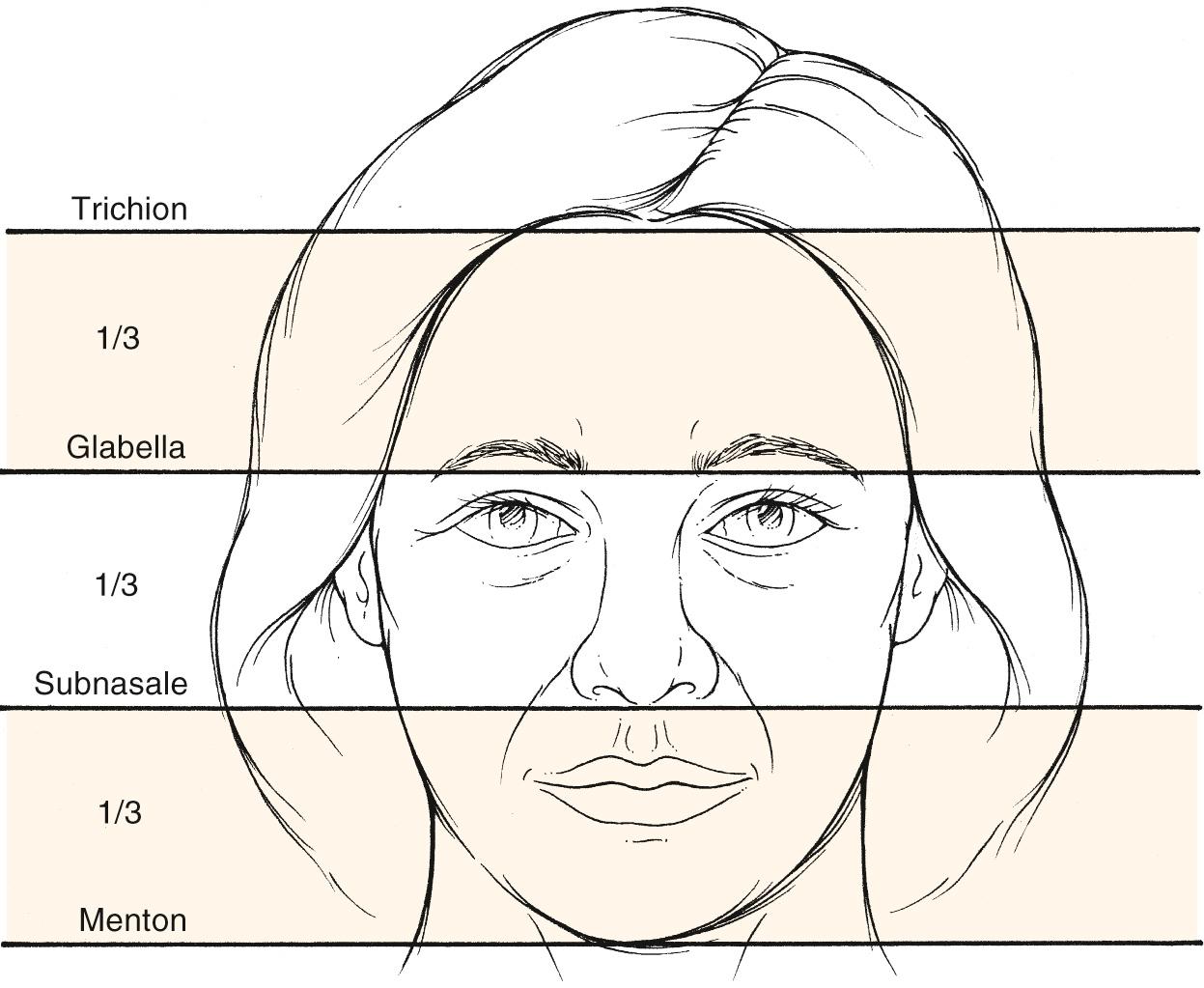
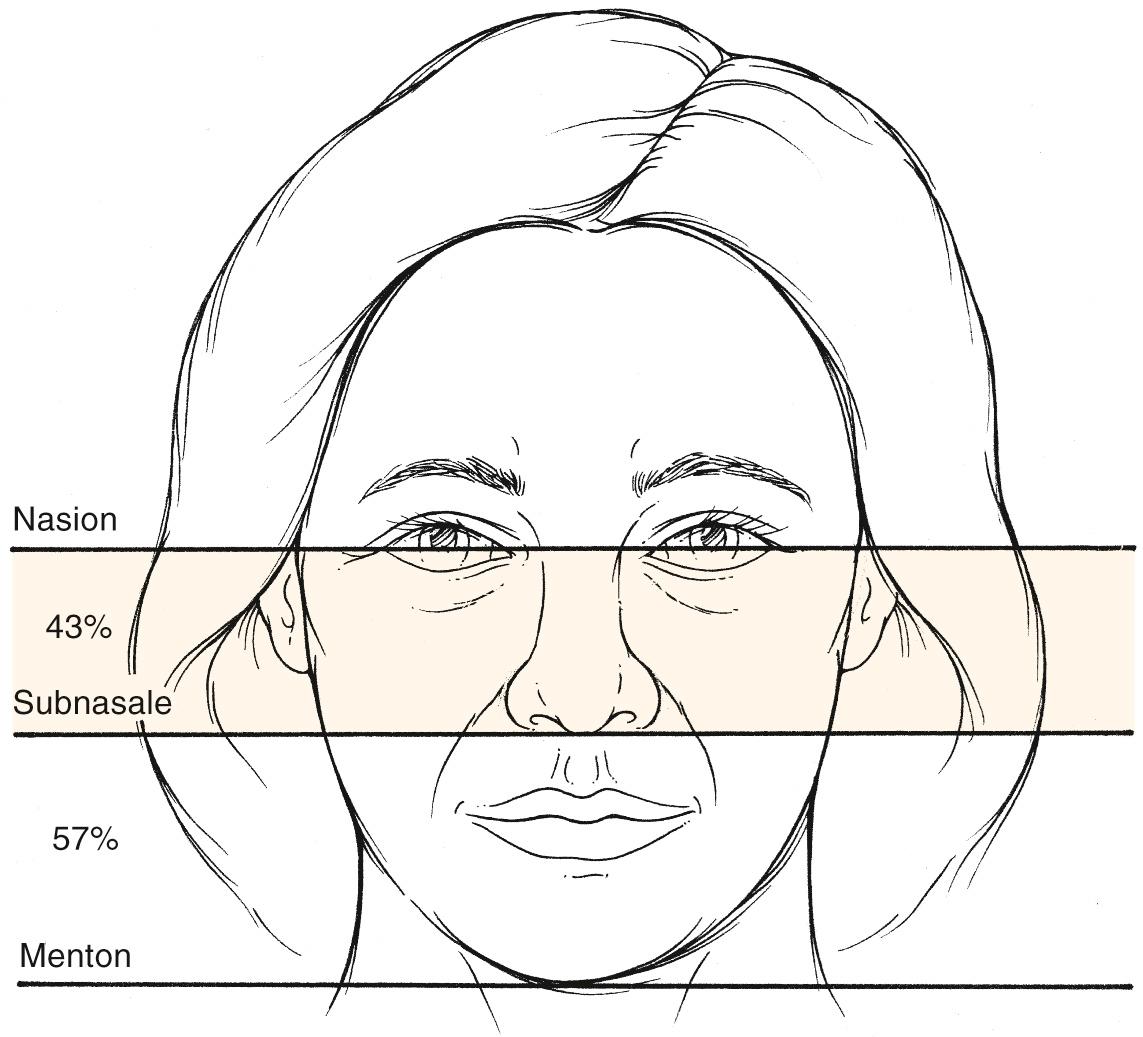
The face is divided into aesthetic units ( Fig. 16.10 ) that are further divided into subunits. The major units that are classically defined for facial analysis include the forehead, eyes, nose, lips, chin, ears, and neck. The units and subunits are based on skin thickness, color, texture, and underlying structural contour. Precise planning of surgical incisions and reconstructions require analysis of the entire unit or subunit. Incisions parallel to relaxed skin tension lines (RSTLs; Fig. 16.11 ) and within unit or subunit borders result in the most favorable scars.
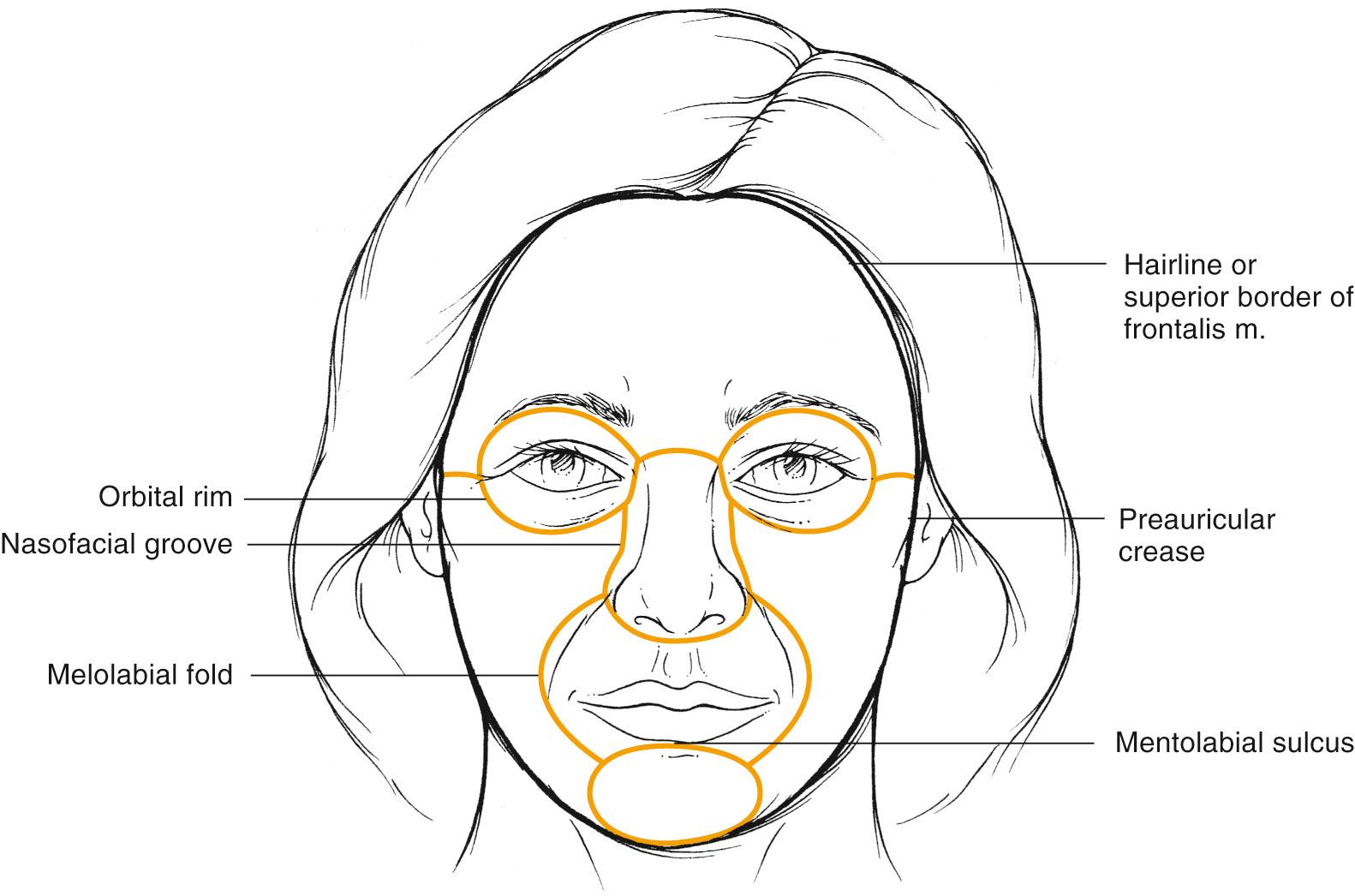
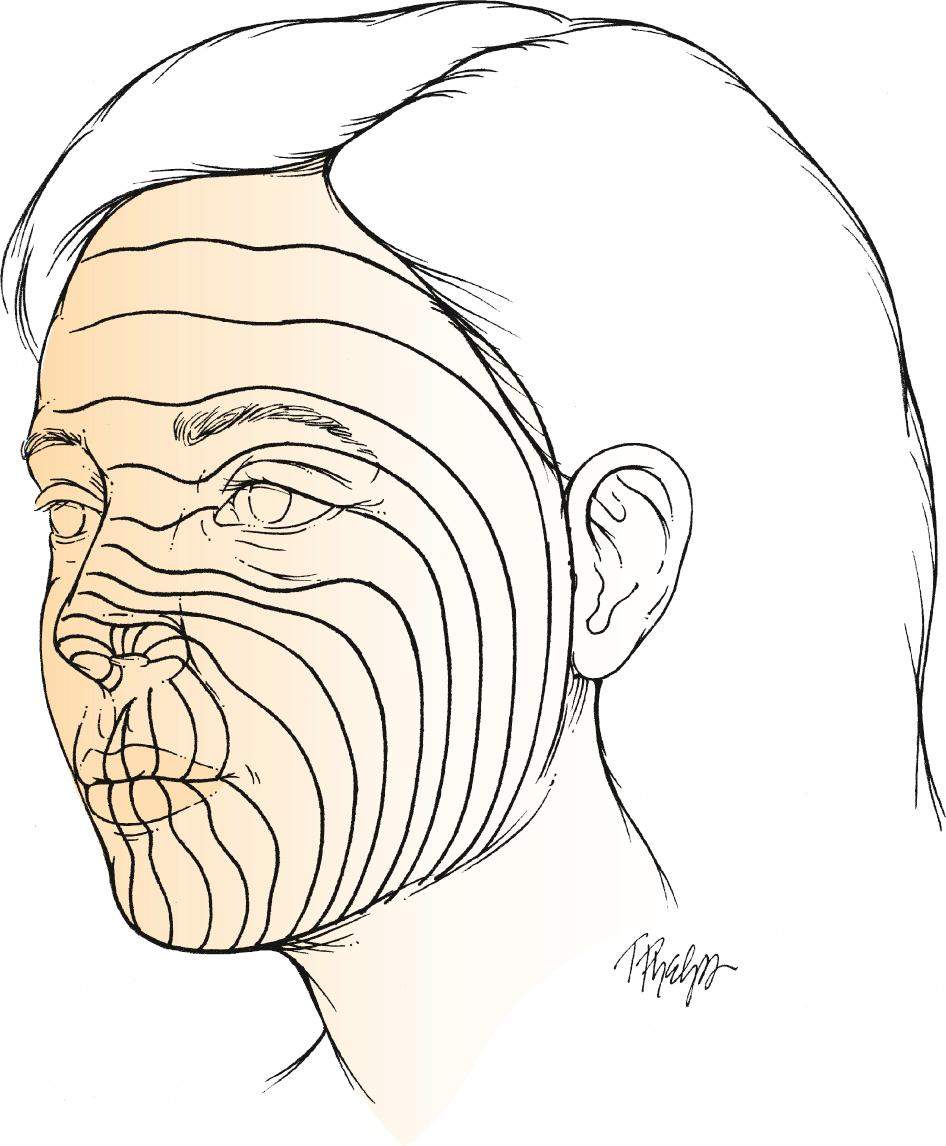
The boundaries of the forehead are from the hairline to the glabella and make up the upper third of the face. The contour anatomy of the forehead is most aesthetically pleasing with a gentle convexity on profile. The nasofrontal angle ( Fig. 16.12 ) is created by a line tangent to the glabella through the nasion and intersecting with a line tangent to the nasal dorsum. The range of aesthetic measurements for this angle is from 115 to 135 degrees.
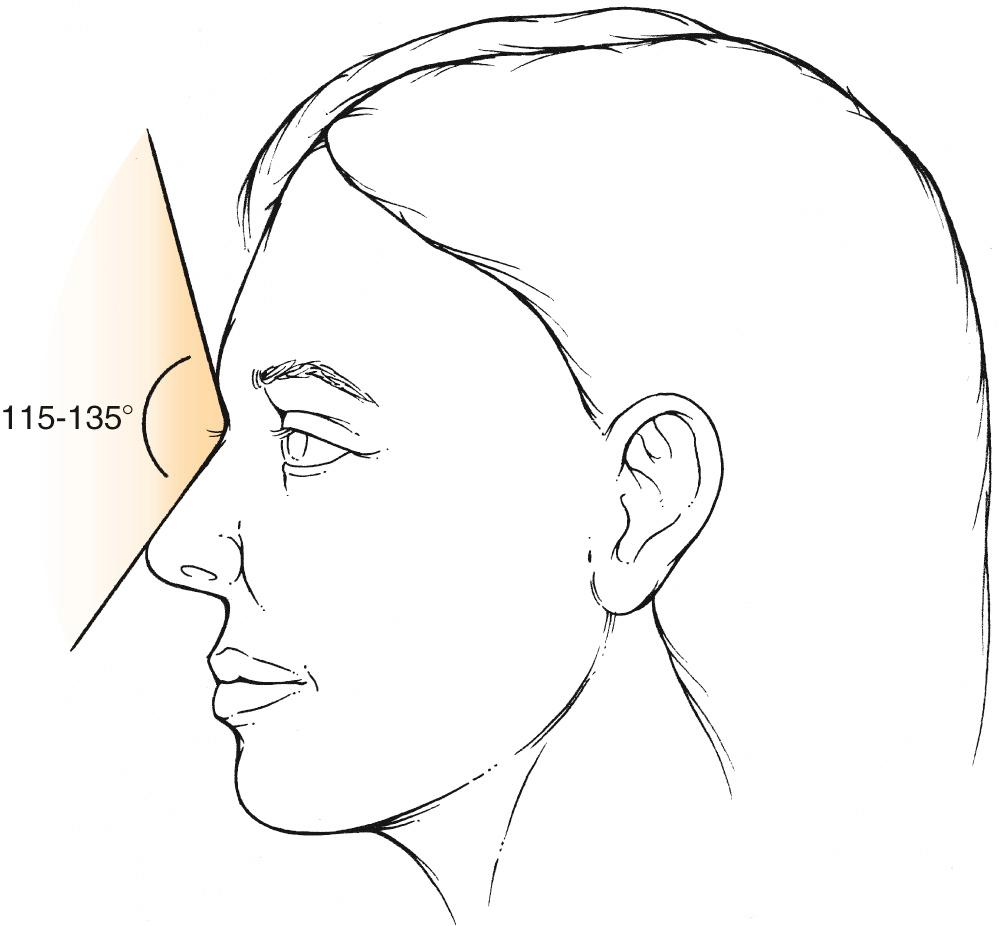
Become a Clinical Tree membership for Full access and enjoy Unlimited articles
If you are a member. Log in here